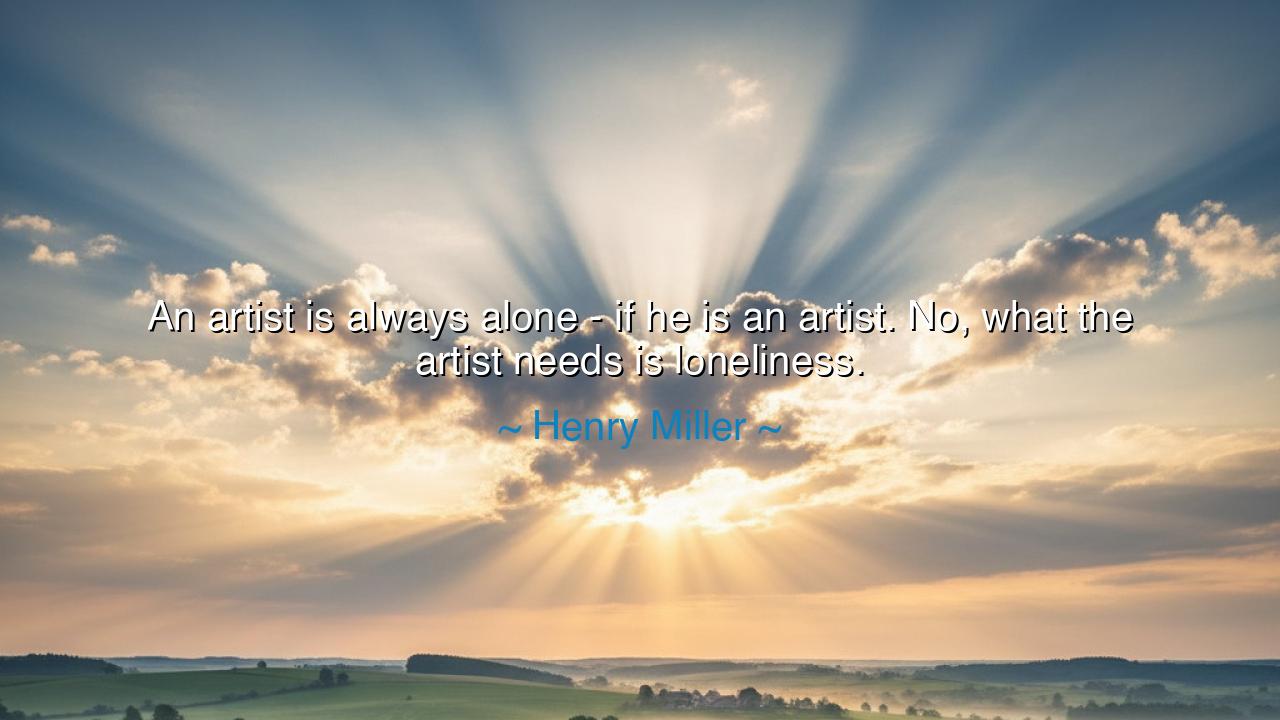
An artist is always alone - if he is an artist. No, what the
An artist is always alone - if he is an artist. No, what the artist needs is loneliness.






"An artist is always alone - if he is an artist. No, what the artist needs is loneliness." These striking words by Henry Miller reveal the deep and often unspoken truth about the creative process: true artistry requires solitude. The artist, in his creative journey, is often an isolated figure, not because he chooses to be, but because the nature of art itself demands it. Loneliness, as Miller suggests, is not something to be feared but something to be embraced. It is in these moments of solitude that the artist is free to connect with his inner world, to dig deeper into his emotions, and to give birth to his most profound works. Loneliness becomes the fertile soil in which the seeds of creativity take root and grow.
In the ancient world, artists and philosophers alike understood that the pursuit of wisdom and beauty required moments of reflection and withdrawal. Plato often spoke of the philosopher’s life as one of contemplation, separate from the distractions of the ordinary world. For the true philosopher, like the artist, the pursuit of truth and beauty often required separation from the crowd, a retreat into solitude where one could clear the mind and hear the voice of the soul. Similarly, the Greek tragedians, such as Sophocles and Euripides, crafted their great works not in the midst of society’s noise, but in the quiet corners of their own thoughts, contemplating the depths of human nature and existence. They knew that true artistry was born not from the hustle of daily life, but from the inner spaces where the soul could speak freely.
In more recent history, the life of Vincent van Gogh serves as a poignant example of the artist’s need for loneliness. Van Gogh, whose paintings now illuminate the world’s greatest galleries, was often isolated in his life, both emotionally and physically. Despite his struggles with mental health, it was in his times of solitude—whether in the quiet of the South of France or in the isolation of the Saint-Paul-de-Mausole asylum—that he produced his most iconic works, such as Starry Night and Sunflowers. Van Gogh’s loneliness allowed him to tap into a realm of creativity that could not have been accessed amidst the noise and expectations of the outside world. His struggle with isolation became, paradoxically, the wellspring from which his genius flowed.
Miller’s quote also speaks to a deeper truth about the nature of creativity itself. The artist must often wrestle with his own inner conflicts, his doubts, and his fears, which are best faced alone. Creative work is an intimate expression of the soul, a process of unearthing something deeply personal and universal at the same time. Shakespeare, for instance, wrote his masterpieces in relative solitude, often drawing upon his own experiences of triumph and tragedy. His loneliness in writing allowed him to explore the full spectrum of human emotion, crafting characters whose joys, sorrows, and fears still resonate with audiences centuries later. The isolation of the artist is thus a necessary stage for transcendence, allowing the artist to explore the depths of the human soul without distraction.
In our own age, the idea of solitude as a vital component of artistic creation remains as true as ever. The rise of social media and constant connectivity has made it more difficult than ever for the modern artist to find the kind of peace and solitude needed for creative work. Yet, the most innovative thinkers and artists continue to emphasize the need for isolation. Writers such as Haruki Murakami and J.K. Rowling have spoken about the importance of carving out time for quiet reflection, away from the chaos of the world. It is in those moments of solitude—when the mind is free from external influences—that the artist can truly engage with his craft, creating works that transcend the moment and connect with the timeless.
The lesson from Henry Miller’s words is one of embracing solitude in the pursuit of greatness. Whether you are an artist, a writer, or someone seeking personal growth, there is immense power in loneliness. It is not something to be avoided, but something to be sought after. In the quiet spaces of our lives, we are able to connect with our deepest thoughts and feelings, and it is there that we can access the wellspring of creativity and insight that will fuel our work.
In our daily lives, we must recognize the importance of solitude in our personal and professional development. Let us not be afraid of the quiet moments but embrace them as opportunities for deep reflection, for clarity, and for the birth of new ideas. Whether through quiet time in nature, moments alone with a journal, or simply stepping back from the noise of the world, we can find solitude to be the creative crucible that shapes our most important work. Like Miller, let us understand that the artist's greatest companion is loneliness, for it is through isolation that we are truly able to hear our own voice and create something that speaks not just to our time, but to the ages.






AAdministratorAdministrator
Welcome, honored guests. Please leave a comment, we will respond soon